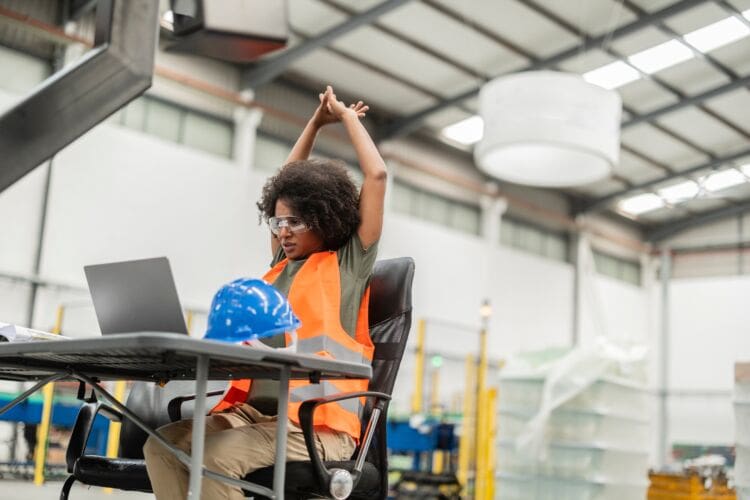In this article
What is Ergonomics?
Ergonomics is when things that people use and the environments they function in are designed and arranged in a particular way so that they can be used more efficiently, safely and comfortably. It involves fitting the activity, task or job to the person rather than forcing the person to fit the job. Ergonomics typically involves designing and arranging workspaces, products and systems to match a person’s capabilities and limitations.
Ergonomics is influenced by multiple fields, including:
- Anatomy and physiology – Understanding how the body moves and functions and the best positions, posture and movements to support the body.
- Psychology – Focusing on how people think, perceive and make decisions and how the environment, their comfort and their pain level can affect their thoughts, emotions and behaviours.
- Engineering and design – Creating tools and environments that are specially designed to support human use.
- Occupational health and safety – Preventing pain and injuries at work and improving workplace conditions.
The goal of ergonomics is to prevent discomfort, fatigue and injury, especially in workplaces where repetitive tasks, poor posture, the types of tools and equipment or the environment itself can cause problems for employees. In 2023/2024, the Health and Safety Executive (HSE) reported that 1.7 million people suffered from a work-related illness or injury in Great Britain, including 760,000 people who experienced work-related stress or mental health difficulties and 543,000 who experienced a work-related musculoskeletal disorder.
Ergonomics aims to create an environment that is safe, comfortable and efficient for people and prevents workplace illness and injuries. Ergonomics is about making small, intentional changes to tools, tasks or environments to fit human needs. This can help to reduce pain, discomfort and injuries at work and increase effectiveness and productivity.
The term ergonomics is more commonly used when talking about workplaces, whereas in other areas, such as healthcare and defence, ergonomics is more commonly called human factors. When we talk about ergonomics and the environment today, we are referring to ergonomics in the workplace.
Why is Ergonomics Important?
Ergonomics is important because it directly impacts health, safety, productivity and quality of life. It is especially important in workplaces where people interact with tools, machines or computers for extended periods. Ergonomic designs consider the diversity of users and help to make systems and environments more inclusive and accessible. Without ergonomics, systems, tasks and tools are designed around convenience or cost rather than people. This can cause multiple issues for employees and when people suffer at work, their performance and work outcomes inevitably suffer too.
Without ergonomics, employees may be at higher risk of:
- Injuries -Without ergonomics, employees may be at higher risk of repetitive strain injuries and musculoskeletal disorders. Non-ergonomic work environments can also cause workers to slouch, hunch or hold awkward positions, which can cause muscular strain and discomfort and result in quicker physical and mental fatigue.
- Higher costs – Without ergonomics, injuries happen more frequently or are more serious. The Health and Safety Executive (HSE) estimates that workplace injuries cost the UK £21.6 billion every year. For workplaces, this includes the costs relating to a loss of production, the costs of paying overtime or temporary staff, an increase in insurance premiums following an injury at work and the cost of legal fees and compensation if the workplace is liable. Additionally, workplaces that haven’t implemented ergonomics may also have more absences and higher employee turnover, all of which can result in higher costs.
- Lower employee morale and job satisfaction – When employees feel unsupported or not cared about at work or they feel pain and discomfort doing work tasks, they are more likely to become less engaged and be less invested in their job. Low morale can also affect the morale of other team members and impact the entire workplace.
- Lower productivity and lower quality of work – When workers are struggling with tools or workplace systems, this is likely to affect their concentration and there is likely to be an increase in mistakes. Employees may find it more difficult to focus on their work and the quality of their work may suffer as a result. Poor posture, awkward movements and repetitive strain injuries can cause pain, discomfort, fatigue and decreased energy levels, which can make it harder for employees to focus and perform their best. It can also lead to an increase in mistakes, which can not only be time-consuming to fix but can also be costly to the company.
- Increased likelihood of employee burnout – Employees with lower job satisfaction who feel they are not being cared for or who may be experiencing pain or discomfort at work are more likely to experience burnout faster. The Burnout Report 2025, from Mental Health UK, found that workplace set-ups, heavy workloads and a lack of reasonable adjustments at work were key triggers for employee burnout. Employee burnout can affect the health, well-being and mental health of employees, can lead to more time off sick and can have a significant impact on productivity at work.

How Does Ergonomics Work?
To be used most effectively, ergonomics is most commonly done by ergonomists. Ergonomists assess existing environments, tools and workflows to identify any issues and make changes to make them better suited to the user (i.e., the employees). Ergonomics typically works by following these steps:
- Assess the task and the environment
The first step in ergonomics is to assess the task and the environment. For example, what workplace tasks are they engaging in and where are they doing the task (e.g., at a desk). Part of the assessment should also look at how the task is done, for example:
- What posture or position does the person have?
- What tools are they using?
- Does the task involve repetitive movements?
- Does the task require the person to use force or extra effort?
- Identify any possible hazards or risks
Once the task and the environment have been assessed, the next step is to identify any possible hazards or risks. This includes looking for signs of:
- Poor posture, such as slouching, leaning down or head forward.
- Repetitive movements, such as typing, lifting or painting.
- The use of excessive force, such as lifting heavy items.
- Awkward movements, such as twisting, stretching or overreaching.
Hazards such as these can lead to fatigue, pain or long-term injuries.
- Design or adjust tools, workflow or the environment to reduce the risks
Based on this information, ergonomic solutions can be found and tools, tasks or the environment can be redesigned to better fit the user. The aim of this is to reduce strain, improve posture and support natural movements and positioning. Equipment can be adjusted or replaced to better support the user and workflows can be redesigned. For example, providing an adjustable chair for lumbar support, using a lifting device to reduce heavy manual lifting or simplifying a cluttered interface for easier navigation.
Education is essential and there is no point in introducing new tools and making changes to the workplace if people don’t know how to use them properly and how to protect themselves. It is important that all staff members are trained on proper posture, how to safely and effectively use ergonomic tools and how to protect themselves at work.
- Evaluate and improve over time
Monitoring and continuous improvement are important. After the ergonomic solutions have been put into place, user feedback (i.e., feedback from employees) should be collected and their levels of comfort and any changes in their performance should be monitored. This ensures that any other adjustments that are required are made and that the ergonomics that are put into place are working as they should be.
Types of Ergonomics
There are several different types of ergonomics:
Physical ergonomics
This is the most well-known type of ergonomics and involves the study of the human body in relation to physical activities. Physical ergonomics focuses on human anatomy, posture and movement, particularly sitting down, repetitive movements, using tools and machinery, lifting objects and the layout of workstations. Physical ergonomics aims to create products that make physical activities easier and more comfortable for the human body and prevent pain and physical conditions. A key goal of physical ergonomics is to understand the human body and the ideal position the body should be in during specific activities, such as working on a computer, sitting down or lifting heavy things. Key areas of physical ergonomics are:
- Workstation design. For example, standing desks to reduce the amount of time spent sitting down, monitor placement and keyboard and mouse setup.
- Repetitive strain and motion injuries. For example, keeping your arms at a 90-degree angle when sitting at a computer or laptop, with the wrists at the same level as the forearms when typing and using keyboards designed to reduce wrist strain.
- Manual handling (e.g., lifting, pushing and pulling). For example, correct positioning when lifting a heavy object from the ground is to squat down, rather than bending down.
- Posture. For example, not slouching when using a laptop, tablet or phone or regularly moving around and stretching if staying in the same posture or position for an extended period (e.g., standing in one place).
- Tool and equipment design. For example, adjustable office chairs that support the worker’s back or control panels in vehicles or machinery being laid out for intuitive use.
- Workplace design layout. For example, improving lighting conditions and the configuration of furniture and equipment.
Ergonomics of specific needs
Ergonomics of specific needs focuses on customising environments, tools and systems to meet the unique physical or cognitive needs of particular individuals or groups, for example, people with disabilities. This type of ergonomics ensures that everyone, including those with disabilities, age-related limitations, chronic pain or injuries, temporary difficulties (e.g., a broken leg), pregnant people or those with special job requirements, can work or interact safely, comfortably and effectively. This increases accessibility and inclusion, improves job comfort, reduces the risk of injury to people with specific needs and encourages independence and dignity. An example would be having wide doorways, ramps and lifts and a wheelchair-accessible desk for a person with mobility issues.
Cognitive ergonomics
Cognitive ergonomics focuses on mental processes, such as memory, attention, perception, reasoning and decision-making. Cognitive ergonomics is concerned with how users interact with systems, especially in environments that are rich with information or high stakes. This could include:
Human-computer interaction
- Usability and interface design.
- Workload.
- Workplace stress.
- Decision-making and error reduction.
- Information processing.
Organisational ergonomics
Organisation ergonomics, sometimes called macro ergonomics, focuses on how systems, teams, policies and workflow are structured within an organisation. It involves optimising how employees interact with work processes and how they interact in teams with other people. Key aspects of organisational ergonomics include:
Work rotas and shift design (e.g., introducing flexible work hours to reduce fatigue).
- Team communication and collaboration.
- Job roles and task distribution (e.g., rotating jobs to avoid repetitive strain).
- Organisational culture and policies.
- Remote working.
Environmental ergonomics
Environmental ergonomics focuses on how environmental factors affect human performance, comfort and safety. It looks at how temperature, noise, lighting, air quality and vibration impact people, especially in work or task-related environments. Environmental ergonomics aims to optimise the work environment so that people can work efficiently, comfortably and safely without their environment causing stress, fatigue or health risks.
Ergonomics can be corrective or preventative. Corrective ergonomics focuses on identifying and fixing existing ergonomic problems that are already causing discomfort, injury or less efficient work. For example, if an employee who works in an office reports that they are experiencing back and neck pain at work, the employer might use corrective ergonomics and introduce an adjustable office chair and a height-adjustable desktop.
Preventative ergonomics is when you designtasks, tools and environments to avoid injuries, discomfort or issues before they occur. It is a more proactive approach as it aims to identify and address issues before they happen. For example, a workplace may conduct an assessment of the work environment, make ergonomic improvements and train employees, even if no issues have been reported.

What is the Aim of Ergonomics?
The main aim of ergonomics is to design work environments, tools, tasks and systems that fit people, rather than the other way around. This helps improve safety, comfort, performance and overall well-being.
Ergonomics has many different goals, including:
- Fitting the job to the person, rather than the person to the job.
- Designing tools, tasks and environments that better fit the user.
- Ensuring user-centred design by designing systems, software and tools that match human needs, capabilities and limitations.
- Improving health and safety by reducing the risk of injuries, preventing long-term musculoskeletal disorders and promoting physical and mental well-being.
- Reducing mental strain.
- Improving productivity and the quality of work by helping people to work faster and more efficiently and effectively with less effort.
- Improving comfort and usability by making tools and environments easier and more comfortable to use and reducing fatigue, awkward positions and unnecessary movements.
- Reducing fatigue and the number of errors that are made at work.
- Designing inclusive and accessible systems that are accessible to all users.
- Increasing job satisfaction and motivation by creating a less stressful work environment and reducing frustration and discomfort.
What is an Ergonomic Hazard?
An ergonomic hazard is any workplace condition or task that puts strain on the body because of poor design, repetition, awkward posture or excessive force. An ergonomic hazard can increase the risk of strain, pain, physical injuries and musculoskeletal disorders. Ergonomic hazards typically occur because of a mismatch between a person and the demands of a task or the environment.
Some common ergonomic hazards include:
- Repetitive movements: A repetitive movement is when you make the same movement over and over again. For example, typing, scanning items at a checkout, mixing or stirring (e.g., when baking cakes) or sawing.
- Awkward positions: An awkward position occurs when you work in an unnatural or strained body position. For example, hunching over a laptop, leaning forward to paint on an easel or reaching up high to organise shelves.
- Forceful exertion: This occurs when excessive physical effort is required to complete a task. For example, lifting heavy boxes, using tools that require force or restraining people. It is important to be aware that what is considered to be forceful exertion for one person may be different for another person.
- Vibration: Regular exposure to vibrations in power tools can cause hand-arm vibration syndrome (HAVS) or other injuries, particularly if you use power tools regularly or for a long time.
- Posture: Holding one posture for too long, such as sitting or standing with little movement for hours, for example, a security guard standing in one place for hours or an office worker sitting at their desk all day, can be a hazard. Awkward or static postures can strain specific areas of the body, restrict circulation and contribute to pain in the back, neck, shoulders and arms and can even lead to long-term health issues.
- Contact stress: If you regularly experience pressure from hard edges or tools, this can cause pain or injury. This most commonly happens to the knees, elbows, wrists or fingers. For example, resting your wrists on the edge of a hard desk while typing or gripping something with your fingers.
- Noise: Many people don’t realise that noise is an ergonomic hazard. Excessive noise can cause stress and potentially lead to hearing loss. Protecting the ears is important in many workplaces.
- Lighting: Inadequate (e.g., poor lighting) or excessive lighting (e.g., lights that are too bright or excessive exposure to blue light) can cause eye strain and headaches.
Ergonomic hazards can cause chronic pain and long-term injuries, such as carpal tunnel syndrome, tendonitis or herniated discs. This can reduce productivity and result in increased absences.
There are several ways to reduce ergonomic hazards, including adjusting tools and the environment to fit the user, redesigning tasks to avoid repetition or excessive force, ensuring employees take regular breaks and stretch, introducing ergonomic tools, providing training to employees and ensuring employees use personal protective equipment (PPE), where necessary.
How Does Ergonomics Help?
Ergonomics helps by creating environments, tools and tasks that are better suited to human capabilities and limitations. The key features of ergonomics are:
- Workplace design: Arranging desks, chairs, monitors and tools to promote good posture and reduce strain.
- Tool design: Creating tools or equipment that are easy to use and minimise the risk of injury.
- Human factors: Considering human limitations and strengths when designing systems, products and work environments.
- Cognitive ergonomics: Designing systems that match how people think and process information.
These features work together to help protect human health and increase comfort, safety and performance.
One of the main reasons why ergonomics is important is because of its role in preventing injuries. Poor ergonomics can lead to musculoskeletal disorders. A musculoskeletal disorder can affect the muscles, nerves, blood vessels, ligaments and tendons in your back, neck, arms and wrists, for example, carpal tunnel syndrome, lower back pain and neck and shoulder injuries. These injuries often develop over time and can be extremely painful and debilitating for the person experiencing it and expensive for the employer. Ergonomics can help prevent musculoskeletal disorders from developing.
Fewer workplace injuries can also reduce costs for the employer. Fewer injuries can mean fewer absences. When an employee has frequent absences or long-term sickness, this can result in high costs for the employer. Not only will they be responsible for paying sick pay, but they may also need to hire a new employee to temporarily cover the role and pay for training.
Ergonomics can prevent the injuries that result in workplace absences, resulting in fewer costs to the employer, less pressure on the NHS (i.e., by reducing the number of people requiring treatment for workplace injuries and illness) and the cost to the UK government (e.g., of paying for long-term sick leave or disability benefits).
Ergonomics can also increase productivity. Ergonomically designed tools and workstations reduce unnecessary motion, effort and discomfort. Ergonomics can reduce fatigue and discomfort when performing work activities, which can increase productivity and result in higher quality of work. Workers who are comfortable and pain-free tend to get more done with higher accuracy, which is beneficial to both them and the workplace.
A comfortable work environment can also reduce fatigue, stress and workplace frustration. This can help improve focus at work and improve mental well-being. Investing in cognitive ergonomics can reduce mental overload at work and allow employees to concentrate better, make better decisions and result in fewer mistakes.
Ergonomics can also help to increase employee satisfaction. When employers invest in ergonomics, workers feel valued and a more likely to have higher morale and greater job satisfaction. Additionally, employees who feel more physically comfortable and supported are generally happier at work, less stressed and more engaged at work. Increased employee satisfaction can also result in lower employee turnover, which can decrease costs for the employer.
An important benefit of ergonomics that many people don’t consider is that it helps workplaces be more inclusive and diverse. Ergonomics allows workplaces to be more accommodating to people of different physical abilities, ages and those with disabilities and differing needs.
Ergonomics also helps to ensure that workplaces are complying with any laws or regulations, such as the Health and Safety at work etc. Act 1974, The Management of Health and Safety at Work Regulations 1999, The Manual Handling Operations Regulations 1992 and the Provision and Use of Work Equipment Regulations (PUWER) 1998.
Some real-world examples of ergonomics in different settings include:
| Ergonomic Solution | Reason it Helps |
|---|---|
| Ergonomic keyboards | Ensure a neutral wrist position and prevent wrist pain and strain |
| Office chairs with lumbar support and adjustable height | Support the lower back and encourage upright posture |
| Lift-assist devices (e.g., for lifting heavy boxes) | Reduce strain on the back and shoulders and reduce the risk of injury |
| Adjusted lighting and blue light filters (e.g., for those working on computers) | Reduces eye strain, fatigue and headaches and prevents long-term damage to the eyes |
| Kitchen tools with non-slip and padded handles | Provide a more comfortable grip requiring less force and can be used by people with limited strength and dexterity |
| Cockpit design on aeroplanes | Minimises the physical and cognitive load for pilots and ensures important functions are more visible and accessible |
| User-friendly software on phones and computers | Ensures the interface is intuitive and requires little cognitive strain from the user, while also helping to reduce errors |
| Anti-fatigue mats | Provide cushioning and support to people who stand up for extended periods |
| Voice recognition software | Means employees don’t need to type, which can reduce the pressure on employees’ hands and wrists and make the workplace more accessible for people with physical difficulties |







